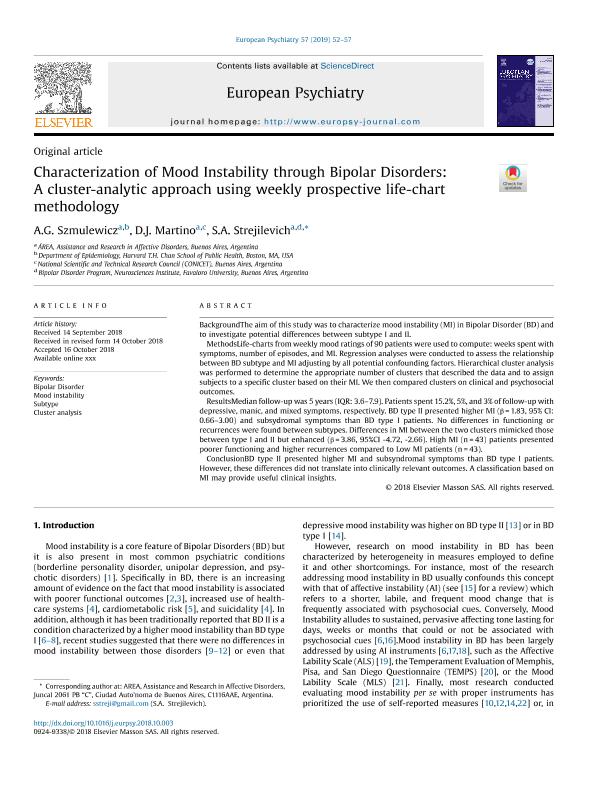Mostrar el registro sencillo del ítem
dc.contributor.author
Szmulewicz, A.G.
dc.contributor.author
Martino, Diego Javier

dc.contributor.author
Strejilevich, S. A.

dc.date.available
2021-01-08T17:22:23Z
dc.date.issued
2019-01
dc.identifier.citation
Szmulewicz, A.G.; Martino, Diego Javier; Strejilevich, S. A.; Characterization of Mood Instability through Bipolar Disorders: A cluster-analytic approach using weekly prospective life-chart methodology; Elsevier France-editions Scientifiques Medicales Elsevier; European Psychiatry; 57; 1-2019; 52-57
dc.identifier.issn
1778-3585
dc.identifier.uri
http://hdl.handle.net/11336/121982
dc.description.abstract
BackgroundThe aim of this study was to characterize mood instability (MI) in Bipolar Disorder (BD) and to investigate potential differences between subtype I and II.MethodsLife-charts from weekly mood ratings of 90 patients were used to compute: weeks spent with symptoms, number of episodes, and MI. Regression analyses were conducted to assess the relationship between BD subtype and MI adjusting by all potential confounding factors. Hierarchical cluster analysis was performed to determine the appropriate number of clusters that described the data and to assign subjects to a specific cluster based on their MI. We then compared clusters on clinical and psychosocial outcomes.ResultsMedian follow-up was 5 years (IQR: 3.6?7.9). Patients spent 15.2%, 5%, and 3% of follow-up with depressive, manic, and mixed symptoms, respectively. BD type II presented higher MI (β = 1.83, 95% CI: 0.66?3.00) and subsydromal symptoms than BD type I patients. No differences in functioning or recurrences were found between subtypes. Differences in MI between the two clusters mimicked those between type I and II but enhanced (β = 3.86, 95%CI -4.72, -2.66). High MI (n = 43) patients presented poorer functioning and higher recurrences compared to Low MI patients (n = 43).ConclusionBD type II presented higher MI and subsyndromal symptoms than BD type I patients. However, these differences did not translate into clinically relevant outcomes. A classification based on MI may provide useful clinical insights.
dc.format
application/pdf
dc.language.iso
eng
dc.publisher
Elsevier France-editions Scientifiques Medicales Elsevier

dc.rights
info:eu-repo/semantics/openAccess
dc.rights.uri
https://creativecommons.org/licenses/by-nc-nd/2.5/ar/
dc.subject
BIPOLAR DISORDER
dc.subject
CLUSTER ANALYSIS
dc.subject
MOOD INSTABILITY
dc.subject
SUBTYPE
dc.subject.classification
Psiquiatría

dc.subject.classification
Medicina Clínica

dc.subject.classification
CIENCIAS MÉDICAS Y DE LA SALUD

dc.title
Characterization of Mood Instability through Bipolar Disorders: A cluster-analytic approach using weekly prospective life-chart methodology
dc.type
info:eu-repo/semantics/article
dc.type
info:ar-repo/semantics/artículo
dc.type
info:eu-repo/semantics/publishedVersion
dc.date.updated
2020-11-20T17:28:09Z
dc.identifier.eissn
0924-9338
dc.journal.volume
57
dc.journal.pagination
52-57
dc.journal.pais
Francia

dc.description.fil
Fil: Szmulewicz, A.G.. Harvard University. Harvard School of Public Health; Estados Unidos
dc.description.fil
Fil: Martino, Diego Javier. Consejo Nacional de Investigaciones Científicas y Técnicas. Oficina de Coordinación Administrativa Houssay. Instituto de Neurociencia Cognitiva. Fundación Favaloro. Instituto de Neurociencia Cognitiva; Argentina
dc.description.fil
Fil: Strejilevich, S. A.. Universidad Favaloro. Facultad de Medicina. Instituto de Neurociencias; Argentina
dc.journal.title
European Psychiatry

dc.relation.alternativeid
info:eu-repo/semantics/altIdentifier/url/https://www.cambridge.org/core/product/identifier/S0924933800009275/type/journal_article
dc.relation.alternativeid
info:eu-repo/semantics/altIdentifier/doi/http://dx.doi.org/10.1016/j.eurpsy.2018.10.003
Archivos asociados
